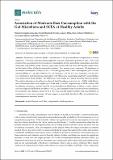Por favor, use este identificador para citar o enlazar a este item:
http://hdl.handle.net/10261/228445COMPARTIR / EXPORTAR:
 SHARE SHARE
 CORE
BASE CORE
BASE
|
|
| Visualizar otros formatos: MARC | Dublin Core | RDF | ORE | MODS | METS | DIDL | DATACITE | |

| Título: | Association of moderate beer consumption with the gut microbiota and SCFA of healthy adults |
Autor: | González-Zancada, Natalia CSIC; Redondo, Noemí CSIC; Díaz-Prieto, Ligia E. CSIC ORCID; Gómez-Martínez, Sonia CSIC ORCID; Marcos, Ascensión CSIC ORCID; Nova, Esther CSIC ORCID | Palabras clave: | Butyric acid Alcohol Fiber Drinking pattern Polyphenols |
Fecha de publicación: | 2020 | Editor: | Multidisciplinary Digital Publishing Institute | Citación: | Molecules 25(20): 4772 (2020) | Resumen: | Fermented alcoholic drinks’ contribution to the gut microbiota composition is mostly unknown. However, intestinal microorganisms can use compounds present in beer. This work explored the associations between moderate consumption of beer, microbiota composition, and short chain fatty acid (SCFA) profile. Seventy eight subjects were selected from a 261 healthy adult cohort on the basis of their alcohol consumption pattern. Two groups were compared: (1) abstainers or occasional consumption (ABS) (n = 44; <1.5 alcohol g/day), and (2) beer consumption ≥70% of total alcohol (BEER) (n = 34; 200 to 600 mL 5% vol. beer/day; <15 mL 13% vol. wine/day; <15 mL 40% vol. spirits/day). Gut microbiota composition (16S rRNA gene sequencing) and SCFA concentration were analyzed in fecal samples. No differences were found in α and β diversity between groups. The relative abundance of gut bacteria showed that Clostridiaceae was lower (p = 0.009), while Blautia and Pseudobutyrivibrio were higher (p = 0.044 and p = 0.037, respectively) in BEER versus ABS. In addition, Alkaliphilus, in men, showed lower abundance in BEER than in ABS (p = 0.025). Butyric acid was higher in BEER than in ABS (p = 0.032), and correlated with Pseudobutyrivibrio abundance. In conclusion, the changes observed in a few taxa, and the higher butyric acid concentration in consumers versus non-consumers of beer, suggest a potentially beneficial effect of moderate beer consumption on intestinal health. | Descripción: | This article belongs to the Special Issue Polyphenolic Compounds in Wine and Bee. | Versión del editor: | https://doi.org/10.3390/molecules25204772 | URI: | http://hdl.handle.net/10261/228445 | DOI: | 10.3390/molecules25204772 | E-ISSN: | 1420-3049 |
| Aparece en las colecciones: | (ICTAN) Artículos |
Ficheros en este ítem:
| Fichero | Descripción | Tamaño | Formato | |
|---|---|---|---|---|
| molecules-25-04772.pdf | 1,26 MB | Adobe PDF |  Visualizar/Abrir |
CORE Recommender
PubMed Central
Citations
8
checked on 23-abr-2024
SCOPUSTM
Citations
13
checked on 15-abr-2024
WEB OF SCIENCETM
Citations
12
checked on 24-feb-2024
Page view(s)
114
checked on 22-abr-2024
Download(s)
163
checked on 22-abr-2024

